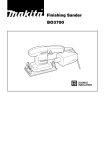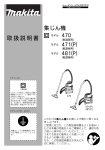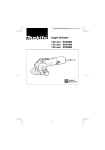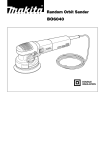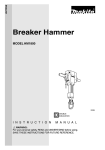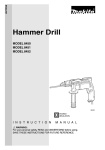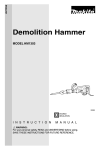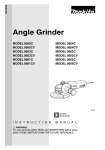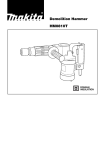Download Makita HR3850 Specifications
Transcript
Rotary Hammer HR3520B HR3850B HR3850K DOUBLE INSULATION SPECIFICATIONS Model HR3520B Capacities Tungsten-carbide bit ....................................................................... 35 mm Core bit ........................................................................................... 79 mm No load speed (min–1) ....................................................................... 440 Blows per min. ................................................................................... 3,300 Overall length .................................................................................... 400 mm Net weight .......................................................................................... 5.8 kg HR3850B HR3850K 38 mm 118 mm 240 2,900 442 mm 7.5 kg 38 mm 118 mm 240 2,900 455 mm 7.5 kg • Due to our continuing program of research and development, the specifications herein are subject to change without notice. • Note: Specifications may differ from country to country. Power supply The tool should be connected only to a power supply of the same voltage as indicated on the nameplate, and can only be operated on single-phase AC supply. They are double-insulated in accordance with European Standard and can, therefore, also be used from sockets without earth wire. For European countries only Noise and Vibration of Model HR3520B EC-DECLARATION OF CONFORMITY The typical A-weighted noise levels are sound pressure level: 95 dB (A) sound power level: 108 dB (A) – Wear ear protection. – The typical weighted root mean square acceleration value is 8 m/s2. The undersigned, Yasuhiko Kanzaki, authorized by Makita Corporation, 3-11-8 Sumiyoshi-Cho, Anjo, Aichi, 446-8502 Japan declares that this product (Serial No. : series production) manufactured by Makita Corporation in Japan is in compliance with the following standards or standardized documents, HD400, EN50144, EN55014, EN61000 in accordance with Council Directives, 73/23/EEC, 89/336/EEC and 98/37/EC. Noise and Vibration of Model HR3850B The typical A-weighted noise levels are sound pressure level: 94 dB (A) sound power level: 107 dB (A) – Wear ear protection. – The typical weighted root mean square acceleration value is 12 m/s2. Yasuhiko Kanzaki CE 94 Noise and Vibration of Model HR3850K The typical A-weighted noise levels are sound pressure level: 94 dB (A) sound power level: 107 dB (A) – Wear ear protection. – The typical weighted root mean square acceleration value is 12 m/s2. Director MAKITA INTERNATIONAL EUROPE LTD. Michigan Drive, Tongwell, Milton Keynes, Bucks MK15 8JD, ENGLAND 2 1 2 3 4 5 6 7 8 3 9 10 11 12 13 14 Symbols The following show the symbols used for the tool. Be sure that you understand their meaning before use. [ Read instruction manual. [ DOUBLE INSULATION 4 ENGLISH 1 2 3 4 5 6 7 8 Side grip Grip base Red dot (Tool holder) Red dot (Tool retainer) Tool retainer Press in Turn 180° Change lever Explanation of general view 9 10 11 12 13 14 15 16 For rotation with hammering For hammering only Wing bolt Depth gauge Switch trigger Core bit Adapter Center bit 17 18 19 20 21 22 23 24 Rod Hex wrench Rear cover Screwdriver Brush holder cap Lock nut wrench Crank cap Hammer grease 12. Secure work Use clamps or a vise to hold work. It’s safer than using your hand and it frees both hands to operate tool. 13. Don’t overreach Keep proper footing and balance at all times. 14. Maintain tools with care Keep tools sharp and clean for better and safer performance. Follow instructions for lubricating and changing accessories. Inspect tool cords periodically and, if damaged, have repaired by authorized service facility. Inspect extension cords periodically and replace if damaged. Keep handles dry, clean and free from oil and grease. 15. Disconnect tools When not in use, before servicing, and when changing accessories such as blades, bits and cutters. 16. Remove adjusting keys and wrenches Form the habit of checking to see that keys and adjusting wrenches are removed from tool before turning it on. 17. Avoid unintentional starting Don’t carry plugged-in tool with finger on switch. Be sure switch is off when plugging in. 18. Outdoor use extension cords When tool is used outdoors, use only extension cords intended for use outdoors and so marked. 19. Stay alert Watch what you are doing. Use common sense. Do not operate tool when you are tired. 20. Check damaged parts Before further use of the tool, a guard or other part that is damaged should be carefully checked to determine that it will operate properly and perform its intended function. Check for alignment of moving parts, binding of moving parts, breakage of parts, mounting, and any other conditions that may affect its operation. A guard or other part that is damaged should be properly repaired or replaced by an authorized service center unless otherwise indicated elsewhere in this instruction manual. Have defective switches replaced by and authorized service center. Do not use tool if switch does not turn it on and off. 21. Warning The use of any other accessory or attachment other than recommended in this operating instruction or the catalog may present a risk of personal injury. SAFETY INSTRUCTIONS Warning! When using electric tools, basic safety precautions should always be followed to reduce the risk of fire, electric shock and personal injury, including the following. Read all these instructions before attempting to operate this product and save these instructions. For safe operation: 1. Keep work area clean Cluttered areas and benches invite injuries. 2. Consider work area environment Don’t expose power tools to rain. Don’t use power tools in damp or wet locations. Keep work area well lit. Don’t use power tools in presence of flammable liquids or gases. 3. Guard against electric shock Prevent body contact with grounded surfaces (e.g. pipes, radiators, ranges, refrigerators). 4. Keep children away Do not let visitors contact tool or extension cord. All visitors should be kept away from work area. 5. Store idle tools When not in use, tools should be stored in dry, high, or locked-up place, out of the reach of children. 6. Don’t force tool It will do the job better and safer at the rate for which it was intended. 7. Use right tool Don’t force small tools or attachments to do the job of a heavy duty tool. Don’t use tools for purposes not intended; for example, don’t use circular saw for cutting tree limbs or logs. 8. Dress properly Do not wear loose clothing or jewelry. They can be caught in moving parts. Rubber gloves and nonskid footwear are recommended when working outdoors. Wear protective hair covering to contain long hair. 9. Use safety glasses and hearing protection Also use face or dust mask if cutting operation is dusty. 10. Connect dust extraction equipment If devices are provided for the connection of dust extraction and collection facilities, ensure these are connected and properly used. 11. Don’t abuse cord Never carry tool by cord or yank it to disconnect it from receptacle. Keep cord from heat, oil and sharp edges. 5 Installing or removing drill bit or other bits (bull point, etc.) (Fig. 3 & 4) 22. Have your tool repaired by an expert This electric appliance is in accordance with the relevant safety rules. Repairing of electric appliances may be carried out only by experts otherwise it may cause considerable danger for the user. Important: Always be sure that the tool is switched off and unplugged before installing or removing the bit. Press in the tool retainer and turn it until the red dots on the tool retainer and the tool holder are aligned. Release the tool retainer. (Fig. 3) ADDITIONAL SAFETY RULES 1. Wear a hard hat (safety helmet), safety glasses and/or face shield. It is also highly recommended that you wear a dust mask, ear protectors and thickly padded gloves. 2. Be sure the bit is secured in place before operation. 3. Under normal operation, the tool is designed to produce vibration. The screws can come loose easily, causing a breakdown or accident. Check tightness of screws carefully before operation. 4. In cold weather or when the tool has not been used for a long time, let the tool warm up for several minutes by operating it under no load. This will loosen up the lubrication. Without proper warm-up, hammering operation is difficult. 5. Always be sure you have a firm footing. Be sure no one is below when using the tool in high locations. 6. Hold the tool firmly with both hands. 7. Keep hands away from moving parts. 8. Do not leave the tool running. Operate the tool only when hand-held. 9. Do not point the tool at any one in the area when operating. The bit could fly out and injure someone seriously. 10. When drilling or chipping into walls, floors or wherever “live” electrical wires may be encountered, DO NOT TOUCH ANY METAL PARTS OF THE TOOL! Hold the tool by the insulated grasping surfaces to prevent electric shock if you drill or chip into a “live” wire. 11. Do not touch the bit or parts close to the bit immediately after operation; they may be extremely hot and could burn your skin. Insert the bit into the tool holder as far as it will go. Press in the tool retainer and turn it a full 180 degrees. Then release it to secure the bit. (Fig. 4) CAUTION: Never use A-type shank bits. They can cause damage to the tool. To remove the bit, follow the installation procedure in reverse. Selecting action mode (Fig. 5) (Not available for HR3520B) Rotation with hammering: For drilling in concrete, masonry, etc., rotate the change lever to the position. Hammering only: For chipping, scaling or demolition operations, rotate the change lever to the position. CAUTION: • Do not rotate the change lever when the tool is running under load. The tool will be damaged. • To avoid rapid wear on the mode change mechanism, be sure that the change lever is always positively located in one of the two action mode positions. Adjusting depth of drilling (Fig. 6) Loosen the wing bolt and adjust the depth gauge to the desired depth. After adjusting, tighten the wing bolt. Switch action (Fig. 7) SAVE THESE INSTRUCTIONS. CAUTION: • Before plugging in the tool, always check to see that the switch trigger actuates properly and returns to the “OFF” position when released. • Do not tape, tie or otherwise secure the trigger in the “ON” position. OPERATING INSTRUCTIONS Side grip (auxiliary handle) (Fig. 1 & 2) For maximum control and safer operation, always use the side grip with this tool. The side grip swings around to either side, allowing easy handling of the tool in any position. Loosen the side grip by turning it counterclockwise, swing it to the desired position and then tighten it by turning clockwise. (Fig. 1) To start the tool, simply pull the trigger. Release the trigger to stop. The side grip can also be installed in the position shown in Fig. 2. Remove the side grip from the grip base by turning the side grip counterclockwise. Screw the side grip on either side of the tool, whichever is convenient. 6 Hammer drilling operation MAINTENANCE Position the bit at the location for the hole, then pull the trigger. Do not force the tool. Light pressure gives best results. Keep the tool in position and prevent it from slipping away from the hole. Do not apply more pressure when the hole becomes clogged with chips or particles. Instead, run the tool at an idle, then remove from the hole. By repeating this several times, the hole will be cleaned out. CAUTION: Always be sure that the tool is switched off and unplugged before carrying out any work on the tool. Replacement of carbon brushes (Fig. 12 & 13) Whenever carbon brushes must be replaced, they cut out the tool automatically. When this occurs, replace both carbon brushes at the same time. Use only identical carbon brushes. CAUTION: When the bit begins to break through concrete or if the bit strikes reinforcing rods embedded in concrete, the tool may react dangerously. Maintain good balance and safe footing while holding the tool firmly with both hands to prevent dangerous reaction. Lubrication (Fig. 14 & 15) This tool requires no hourly or daily lubrication because it has a grease-packed lubrication system. Lubricate the tool every time the carbon brushes are replaced. Run the tool for several minutes to warm it up. Switch off and unplug the tool. Remove the crank cap using a Makita lock nut wrench 35 (optional accessory). Rest the tool on the table with the bit end pointing upwards. This will allow the old grease to collect inside the crank housing. Wipe out the old grease inside and replace with a fresh grease (60 g). Use only Makita genuine grease (optional accessory). Filling with more than the specified amount of grease (approx. 60 g) can cause faulty hammering action or tool failure. Fill only with the specified amount of grease. Reinstall the crank cap and tighten with the lock nut wrench. Do not tighten the crank cap excessively. It is made of resin and is subject to breakage. Chipping / Scaling / Demolition Hold the tool firmly with both hands. Turn the tool on and apply slight pressure on the tool so that the tool will not bounce around, uncontrolled. Pressing very hard on the tool will not increase the efficiency. Core bit (optional accessory) When using the center bit Screw the core bit on the adapter. Install the adapter with the core bit in the tool in the same manner as a drill bit. (Fig. 8) Install the center bit. (Fig. 9) Rest the core bit on the concrete and turn the tool on. Once the core bit has cut a shallow groove into the concrete, remove the center bit. Then resume drilling. To maintain product safety and reliability, repairs, maintenance or adjustment should be carried out by a Makita Authorized Service Center. To remove the core bit, follow the procedures (1) or (2). (1) Rotate the change lever to the position. Then rest the core bit on the concrete and turn the tool on. The core bit will come loose from the hammering action. (Fig. 10) (2) Hold the adapter with the wrench, insert the rod (optional accessory) into the hole in the core bit and tap with a hammer to unscrew. (Fig. 11) When not using the center bit Screw the core bit on the adapter. Install the adapter with the core bit in the tool in the same manner as a drill bit. (Fig. 8) Rotate the change lever to the position. Rest the core bit on the concrete and turn the tool on. Once the core bit has cut a shallow groove into the concrete, rotate the change lever to the position and resume drilling. NOTE: No problem is caused even if the core bit unscrews slightly during brief use since the core bit rotates in the tightening direction. To remove the core bit, follow the same removal procedures covered in When using the center bit. 7 Made in Japan 883660H1








